The 21st Century Classroom: Flooring for Learning
How premium rubber flooring supports exceptional learning environments.
![]() Continuing Education
Continuing Education
Use the following learning objectives to focus your study while reading this month’s Continuing Education article.
Learning Objectives - After reading this article, you will be able to:
- Discuss the importance of the physical learning environment and how premium rubber flooring fosters reduced absenteeism and speech intelligibility as a performance driver for students and teachers.
- Examine the role of premium rubber flooring in the built environment as a component to achieving educational goals through improved indoor air quality to reduce allergy and asthma issues with a never waxed or coated floor.
- Review the influence of the built environment on 21st century learning and ways in which a GREENGUARD Gold-certified sustainable premium rubber flooring supports safety, health, and wellness.
- Describe how flooring performance characteristics address exposure and risk with improved indoor air quality, reduced absenteeism, lower maintenance outlay, reduce musculoskeletal fatigue, operational cost savings, reduce surface contamination, reduce slips, trips, and falls, and improve speech intelligibility and sustainable life-cycle cost.
“Look at your learning space with 21st century eyes. Does it work for what we know about learning now or what we knew about learning in the past?” —The Third Teacher
Design innovation in educational facilities at all levels is undergoing a revolution. The multi-author book, The Third Teacher: 79 Ways You Can Use Design to Transform Teaching & Learning, summarizes many of the most important emerging concepts about the impact of the physical environment on teaching and learning.i Evidence-based design—making design decisions based on research about how aspects of the physical environment directly influence human performance and well-being—has transformed health-care architecture, measurably improving outcomes for patients, families, and staff. Now, the same principles are being applied to the design of spaces for learning. A growing body of research and many impressive examples around the country show an exciting range of new products and ideas for learning environments that give students what they will need to succeed as global citizens in a complex, technological world.
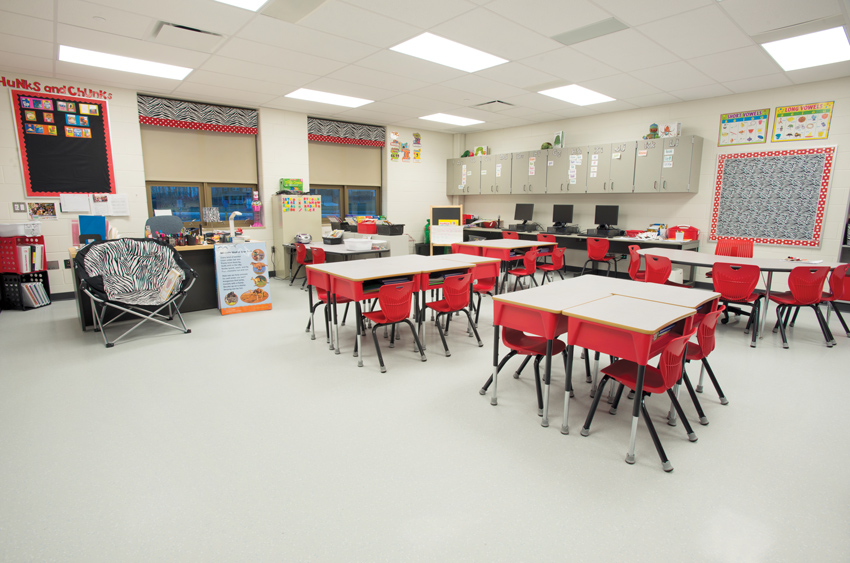
All images courtesy of nora systems, Inc.
The premium rubber flooring product selected for the new Thornwilde Elementary School in Hebron, Kentucky, has essentially become a standard for all Boone County Kentucky School District’s new construction and renovation projects, based on experience with the flooring’s performance, durability and low maintenance in schools throughout the district since the early 2000s.
The materials selected for these new spaces are key to the success of the most innovative designs but also to ensuring the most fundamental needs—healthy air, good light, clear sound, physical safety, and comfort. Even the best decisions about curriculum, assessment, teaching methods, and other important issues can be instantly undermined in the classroom by inferior materials; for example, if students can’t hear or teachers have to repeat themselves, if the air quality is unhealthy, or if the floors are hard and unsafe.
On the flip side, physical environments with properly selected materials, effective light, and forward-thinking design have been shown to improve student performance and teacher success on a wide range of measures from test scores to absenteeism to reduction in headaches and asthma.
As with other materials in educational settings, flooring has to perform in new ways. Rubber as a flooring material has many inherent advantages, but there are significant differences even among rubber flooring products (see Figure 1). Premium rubber flooring differs in quality of ingredients, manufacturing, surface density, and performance characteristics that allow it to respond to new demands. The most functional rubber flooring products can stand up to collaborative floor plans and moveable furniture, foster communication by reducing unwanted and confusing sound, and provide the comfort and safety that aids concentration and reduces distraction. They help maintain healthy air quality and can be thoroughly cleaned without harmful chemicals, eliminating the fumes, labor, and disruption of stripping, waxing, and recoating.
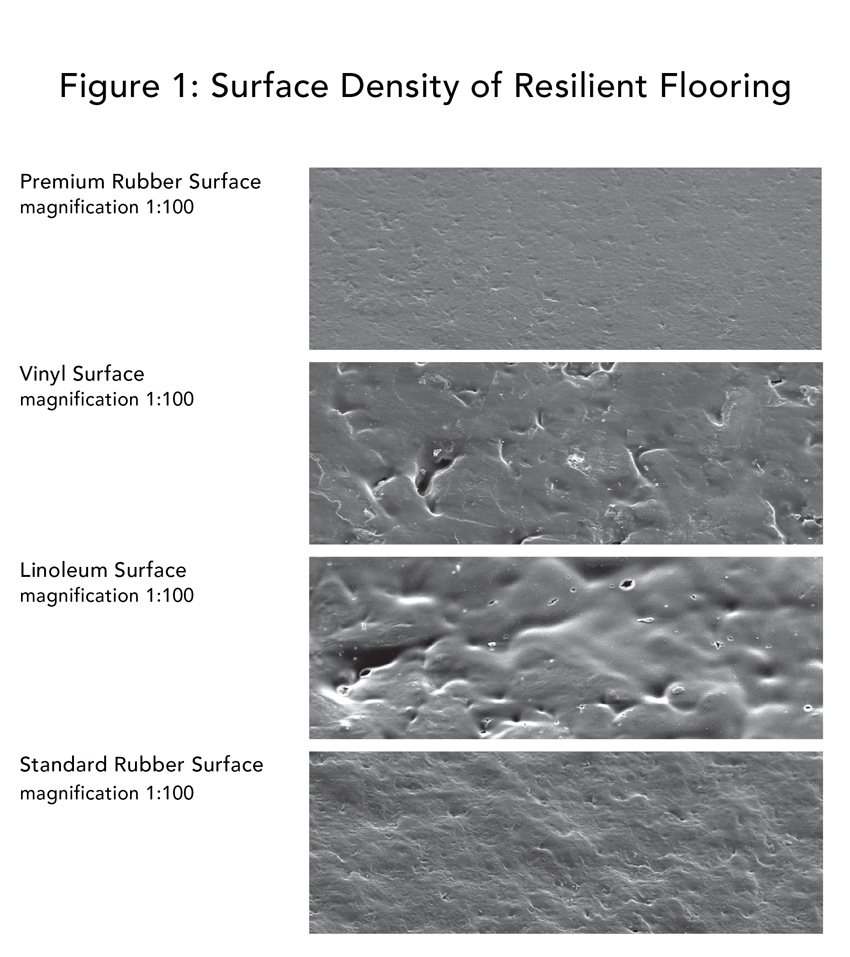
The advantages of high surface density include improvements in safety, acoustics, resistance to dirt and microorganisms, and ease of maintenance.
The large majority of schools are not built to optimize learning, health, and comfort, but to achieve minimum performance at the lowest cost. Many older classrooms are actually working against basic health and safety. Whether for brand new spaces or badly needed renovations, decisions about flooring will have a direct impact on the success of students and teachers for many years to come.
This course will illustrate how premium rubber flooring supports some of the most important new concepts in the creation of exceptional learning environments. Although most of the emphasis is on teachers and kids in K-12, the information is just as important and relevant to students of every age, from the littlest learners in daycare and pre-K spaces, to higher-education facilities and technical and career spaces for lifetime learning.
AGE OF COLLABORATION: DON’T STAY IN YOUR SEATS
The exact list of core concepts in today’s best thinking about education differ, depending on the focus of the list maker—sometimes there are three “Cs,” sometimes five or more. But three are on almost every list: collaboration, communication, creativity. The days of every student sitting quietly in his or her chair for hours at a time, desks lined up in front of a teacher who is the only one speaking, are gone, or at least educators are trying hard to show how counter-productive that scenario can be.
Beyond learning a set body of knowledge, students today are preparing for a future that will require teamwork on small scales and global scales, quick learning, and the ability to do many different jobs in a lifetime, most of which probably do not exist yet. An “agile classroom” is a learning space that can be reconfigured on a dime to engage different kinds of learners and to enable teachers to become guides, marshalling resources for groups of kids who are learning to think on their own and find the information they need. Students move their furniture easily to make small, project-based groups or find space to study alone undisturbed. Different learning styles are accommodated and encouraged. Communication skills are learned in one-to-one exchanges with teachers and other students, and through forms of media that we all use now and ones that we are just now inventing. Creativity thrives where technology connects the classroom to people, places, and networks all over the world, along with problems to solve and the capabilities to do it.
The physical environment has to be up to the challenge of these new ideas. In a classroom of the “old” model—which unfortunately still exists in most schools—the rich, active, agile learning environment described above, with its moving kids and moving furniture, would lead to a noisy, clattering, chaotic atmosphere. Floors would be scratched and stained at the very least, and often slippery with hard, unforgiving surfaces.
To provide a safe and effective foundation for a good learning environment, the flooring must perform well in several key areas discussed in the following sections: physical safety, healthy air quality, good acoustic performance, visual and ergonomic comfort, and the practical realities of today’s educational buildings requiring low maintenance, durability, and sustainability.
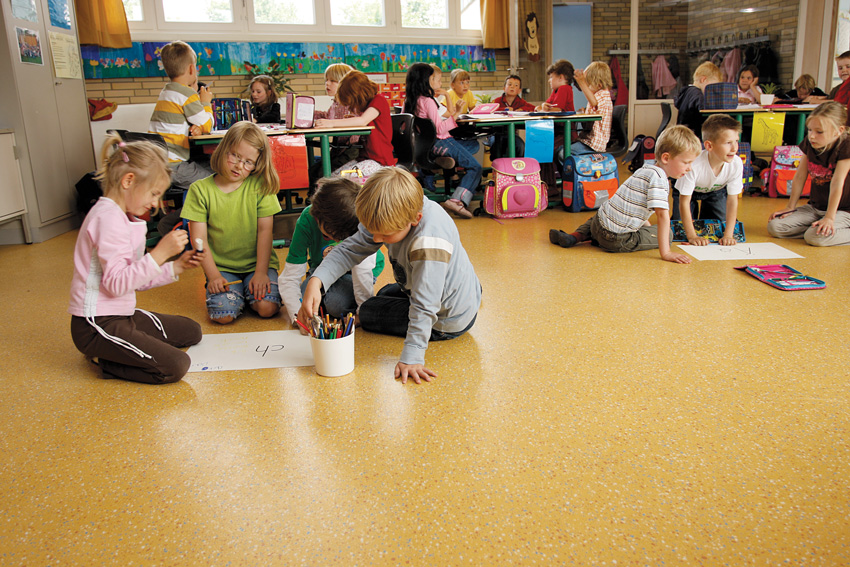
Exceptional learning environments emphasize movement and collaboration. In early grades especially, students need a comfortable, safe, healthy, and easy-to-clean floor.
SAFETY IN NEW CONFIGURATIONS
The best new designs in learning environments emphasize movement. Research discussed in The Third Teacher continues to confirm a deep connection between movement, learning and brain development. When students are allowed to move around more, the ability to concentrate actually improves. In one example, ergonomic chairs that could swivel, rock, and otherwise respond to adjustment resulted in better test scores. Even “fidgeting” is more productive for learning than sitting for long periods in rigid furniture.
In a space where teachers and students are often in motion, the slip-resistant surface of rubber flooring reduces the likelihood of falls. Its ability to absorb energy can help prevent or reduce injuries when falls inevitably occur. Rubber floors are not only safer to move on, they are safer to fall on. Added traction is particularly important in areas where large numbers of people are moving quickly most of the day, such as hallways, stairwells, cafeterias, and gymnasiums.

McMaster University, Hamilton, Ontario, Canada, initially tested a premium rubber flooring product in one of the school’s busiest buildings. “There is a stairwell right by the road that receives most of the foot traffic into the building. The landings were previously VCT and didn’t stand up,” says Craig MacDonald, director, maintenance and facility services. “We replaced it completely with rubber stair treads and rubber tiles on the landings. Thousands of students walk up and down those staircases every day—and they still look fantastic.” From there, the university so far has used the product in the student health services area, laboratory renovations, elevators, and its three largest libraries, one of which is shown here.
Slip resistance can be increased by texture in the surface, but at some point there are trade-offs with cleanability, and maximum traction isn’t desirable in places where people need to be able to walk easily or move equipment. An optimum level of slip resistance for the use of the space is required. When people have confidence that the flooring is not slippery, the stress of walking and standing is reduced.
But slip resistance in flooring is complex to evaluate. Slips are often caused by the floor’s surface, as opposed to trips caused by factors like changes of level, damage, or obstacles. The pattern and transitions in flooring surfaces have an effect on perception. The flooring material’s firmness directly affects the posture and balance of people walking or standing on it.
Some of the key environmental factors that relate to slip resistance include the friction between the floor and the shoe, the presence of micro-roughness in the material, the hardness of the floor, and the finish of the floor, including applications for sealing during installation and later for varnishing, sealing, or polishing.
Premium rubber flooring does not require coating or polishing, so the surface does not have the type of gloss that can cause slipperiness (and create a visual perception of slipperiness, which in itself can be a hazard). Products are also available in a range of thicknesses and textures to provide precise balances of energy absorption, adequate cushioning, and firmness.
Coefficient of friction (COF) represents the resistance an object encounters in moving over another—in this case, a foot over the floor. High COFs indicate greater friction and less slip potential. For example, ice, which has a COF of 0.2, is more slippery than swept concrete, which has a COF of 0.9.
COF is often considered the only relevant component of slip resistance, but it is complicated to measure effectively and consistently. Although OSHA has no mandatory standard for COF, it has published guidelines in the past that recommend a COF greater than 0.5 as a reasonable level, while noting that there are many applications where greater slip resistance is needed. This is also the minimum value of the commonly used James Test (so named because it uses a slip-resistance machine developed by Sidney James at Underwriters Laboratories; it is also the basis for ASTM Standard D2047: Standard Test Method for Static Coefficient of Friction of Polish-Coated Flooring Surfaces as Measured by the James Machine). But not every floor is subjected to this test. In fact, there is currently no single slip-resistance test method applied consistently to both coated and non-coated resilient flooring.
As a result, two rules of thumb are useful when evaluating slip-resistance test results. First, check to see if the test was conducted by an independent company, which helps ensure accurate results. Second, flooring should be tested with its intended use in mind. For example, if the flooring requires five coats of polish, then it should be tested after five coats of polish have been applied. If the manufacturer states that no coating is required, then the floor should be tested without a coating. Some premium rubber flooring products achieve high slip-resistance ratings even immediately after cleaning, which ensures safe use of the space without delay.
The option considered most useful for comparing the COF of resilient flooring is to test using a modified version of ASTM D2047, without polish (unless the flooring requires it) and using a sensor made of dry neolite (the material of most of today’s shoe soles). This test method is currently being developed by the ASTM F06 committee. Most resilient flooring manufacturers already use this method and publish the values. The flooring manufacturer should provide testing reports, including the test method and the machine and sensors used, and if possible, testing information on pre-aged samples of the product to indicate long-term performance.
AS BASIC AS AIR
“Make janitors guardians of the indoor environment. Choose cleaning products, materials, and technology wisely, and teach maintenance staff best practices.” —The Third Teacher
It may seem extreme to question the very air that students and teachers are breathing, but unfortunately the problems in many of today’s classrooms do start there. Among the disturbing facts noted in The Third Teacher: asthma is the most common chronic disorder in childhood—currently affecting 16.2 million children under the age of 18. Asthma is the leading cause of absenteeism, responsible for more than 20 million missed school days in the United States per year. The air is unfit to breathe in an estimated 15,000 American schools.
Physical products and materials in the classroom, including flooring, have a direct impact on indoor air quality in two important ways: first in their basic composition, and then in their maintenance profile throughout their product life.
First, many materials emit large quantities of volatile organic compounds (VOCs), a hazard not only to occupants of the space but also to the environment at large. The VOC emissions of an interior floor product are related to the material’s composition. Creating products that perform well but contain low or no VOCs is a challenging engineering and chemical problem that flooring manufacturers have worked to solve, with varying success.
Some materials are inherently less hazardous than others because they contain fewer synthetics, chemicals, and petroleum. Premium rubber flooring is composed of ingredients including natural rubber, a sustainable resource, and does not include previously used materials, such as tires or chemicals like plasticizers. Even very common materials, such as some forms of polyvinyl chloride (PVC), have become controversial for containing components like phthalates, which can be dangerous during manufacturing and disposal and as they age in place in buildings. Some of these ingredients are implicated in asthma and other diseases. Their use has been banned in some countries.
The second major threat posed by materials to indoor air quality is maintenance. For many flooring materials, extremely harsh chemicals are required both for daily routine cleaning and for more extensive stripping and waxing, once a year or more, when spaces must be closed for weeks at a time to complete the work. Teachers and students are constantly exposed to strong lingering fumes, which is not healthy for anyone but especially problematic for kids with asthma. Children in general are much more sensitive to chemical exposure than adults.
Flooring products in educational settings should contain low to no VOCs, including the adhesives used, and be completely free of substances like phthalates, halogens, and chlorine. Exceptional indoor air quality and green cleaning requirements can contribute to LEED credits.
GREENGUARD Gold Certification helps facilities meet the the most demanding indoor air quality criteria. Created by the GREENGUARD Environmental Institute (GEI), this product certification program for low-emitting building materials, furniture, finishes, cleaning products, electronics, and consumer products is one of the most stringent and rigorous indoor air quality certification programs in the world.
All GREENGUARD Gold Certified products must meet requirements that include limits outlined in California’s Department of Public Health Services Standard Practice for Specification Section 01350. These products undergo both annual recertification and quarterly quality monitoring to ensure ongoing compliance. The certification is also recognized and accepted by a number of green building programs, including LEED.
Rubber flooring products are inherently antimicrobial, bacteriostatic, and fungistatic, providing additional protection for the health of students, staff, and visitors by inhibiting the growth and reproduction of harmful microorganisms.
In the Grand Valley School profiled in this course (see Case Study), one more unexpected benefit from the rubber flooring has been observed by district authorities over the 10 years since its installation: a significant improvement in the efficiency of the school’s HVAC system. The ability to clean the floors easily and thoroughly has translated to less dust and debris accumulating in the HVAC system, a cost saving and another contribution to exceptional indoor air quality.
CAN YOU HEAR ME?
“Acoustics isn’t just for concert halls. Using sound-absorbent materials in classrooms is a simple and effective way to ensure that teachers can focus on teaching, not repeating.” —The Third Teacher
Another basic but often unmet requirement in the learning environment is the ability of everyone to hear and be heard clearly: teachers, other students, and in most classrooms today, audio from a range of devices. Classrooms have become multimedia communication environments, further increasing the importance of classroom acoustics. Yet noise levels in classrooms are often so high that they significantly interfere with teaching and learning. The Acoustical Society of America estimates that many classrooms feature a speech intelligibility rating of 75 percent or less. That means listeners with normal hearing can understand only 75 percent of the words read from a list. Students with hearing difficulties or without fluency in English will have even more severe problems.
Good acoustics for learning enable easy verbal communication, which requires low noise levels and very little reverberation. Flooring, along with other materials in the classroom, can have a positive impact on communication and the ability to hear and learn. It may not be realistic to create a concert hall in every classroom, but new findings about the nature of unwanted noise and how to deal with it are suggesting practical solutions.
Acoustic performance is derived from a combination of sound absorption, reverberation, and transmission of impact sound. Materials selection, particularly of ceilings, walls, and flooring, plays an important role in reducing the unwanted noise that interferes with an effective learning environment. Most common building materials transfer noise throughout a space, but rubber flooring reduces the amount of sound being generated, which helps to control unwanted ambient noise.
The term for a range of common sounds caused by normal activity in a space is “footfall sound.” Footfall sound, which can result in unwanted noise and clatter, is transferred into classrooms through slabs, walls, and other structures; for example, from students talking or walking through adjoining corridors or hallways. The use of thicker rubber flooring (for example, 3–4 millimeters) and premium products designed for acoustic performance can dampen this excess noise. A common misconception is that carpets offer the only solutions to noisy environments. In fact, tests comparing measurements between some premium rubber flooring and common carpets show nearly identical acoustic ratings.
Footfall sound can be reduced with absorbent acoustic rubber flooring. Noise generated by walking on these rubber floors, especially with “hard” shoe soles, can be significantly lowered. Compared with conventional hard floor coverings, these products create superior room acoustics that can also reduce other forms of noise.
Evaluating Acoustic Testing
Testing and measuring a material’s acoustic performance is complex, so it is helpful to look at what different test results mean for a flooring’s actual performance in the built environment.
- ASTM E2179 Standard Test Method for Laboratory Measurement of the Effectiveness of Floor Coverings in Reducing Impact Sound Transmission through Concrete Floors is the test that specifiers should reference and the one used by resilient floor manufacturers marketing their products’ acoustic performance.
- Results of this test include both impact insulation classification (IIC) and delta IIC (∆IIC). (See below for further explanation of these values.)
- ASTM E2179 results are relevant if noise is a concern from either the room above or below. The entire ceiling and subfloor assembly on its own will typically reduce the sound transmission above or below the room. Ask for the ∆IIC Test Report to make a meaningful comparison.
- ASTM E492 Standard Test Method for Laboratory Measurement of Sound Transmission Through Subfloor-Ceiling Assemblies Using the Tapping Machine does not allow for ∆IIC. It is important that the specifier and client partner are informed as to the differences between IIC and ∆IIC.
Understanding IIC and ∆IIC
- It is important to test both with and without the flooring installed so a facility’s ceiling and subfloor assembly can be calculated out.
- The resulting value is for flooring only.
- That value is stated as a ∆IIC (the delta is the difference when the ceiling and subfloor assembly is out of the equation).
- Higher values represent better sound absorbency.
- For example, at first glance, flooring with a ∆IIC value of 14 does not compare well with another flooring system that has an overall IIC value of 34.
- However, the 34 value is for the complete flooring system—not just the flooring material—and includes the ceiling and subfloor assembly (in this case, a concrete subfloor).
- The ASTM E2179 baseline reference for concrete floors is an IIC of 28.
- If this is netted out, the true ∆IIC for the flooring alone can be calculated and turns out to actually be 6 (34–28), which is much lower than the ∆IIC value of 14 for the higher-performing alternative.
- To make informed decisions, verify that values are stated in ∆IIC for comparative analysis.
Many product manufacturers represent their information in the European Union (E.U.) utilizing the ISO 140 test method, which is very similar to ASTM E2179. The calculated improvement in impact sound insulation value of the flooring is reported as a ∆ Lw = value dB. This is simply a different measuring system, like comparing metric and U.S. customary units. Similar to the IIC, the results for comparative analysis must be ∆ Lw dB.
A recent independent study on noise generation, conducted by Intertek, demonstrated that rubber produced the least impact noise when installed directly on a concrete subfloor. Comparative noise generation testing was performed on nine different floor coverings. A repeatable test method was conducted on each of the floor coverings installed on a concrete subfloor and in the center of the same hemi-anechoic chamber (sound-absorbing room). A loud tapping machine was placed in four standard tapping positions at the center of the room in accordance with ASTM E492 testing methods. Using the same tapping machine, measurements were taken one meter away from the tapping machine at a height of 5 feet to simulate an operator’s ear position.
In the test results shown below, the lower the value, the quieter the space. The results indicate that, when tested under identical conditions, there is a significant difference amongst the most widely available commercial floor coverings.
Acoustic rubber flooring in learning environments contributes to a quieter, more productive space that fosters concentration, communication, and comfort.
Although ANSI Standard S12.60 for Classroom Acoustics is not mandatory, it has been adapted by many school systems and partially incorporated into LEED for Schools. First released in 2002 and updated in 2010, the standard is based on the work of a number of organizations, including the Acoustical Society of America, the American Speech-Language-Hearing Association’s Working Group on Classroom Acoustics, and the U.S. Access Board. ANSI Standard S12.60 contains specific design requirements and performance criteria to help create a classroom environment that optimizes speech understanding. Among the criteria: background noise levels in unoccupied classrooms must not exceed 35 dBA, and reverberation time must not exceed 0.6 to 0.7 seconds.
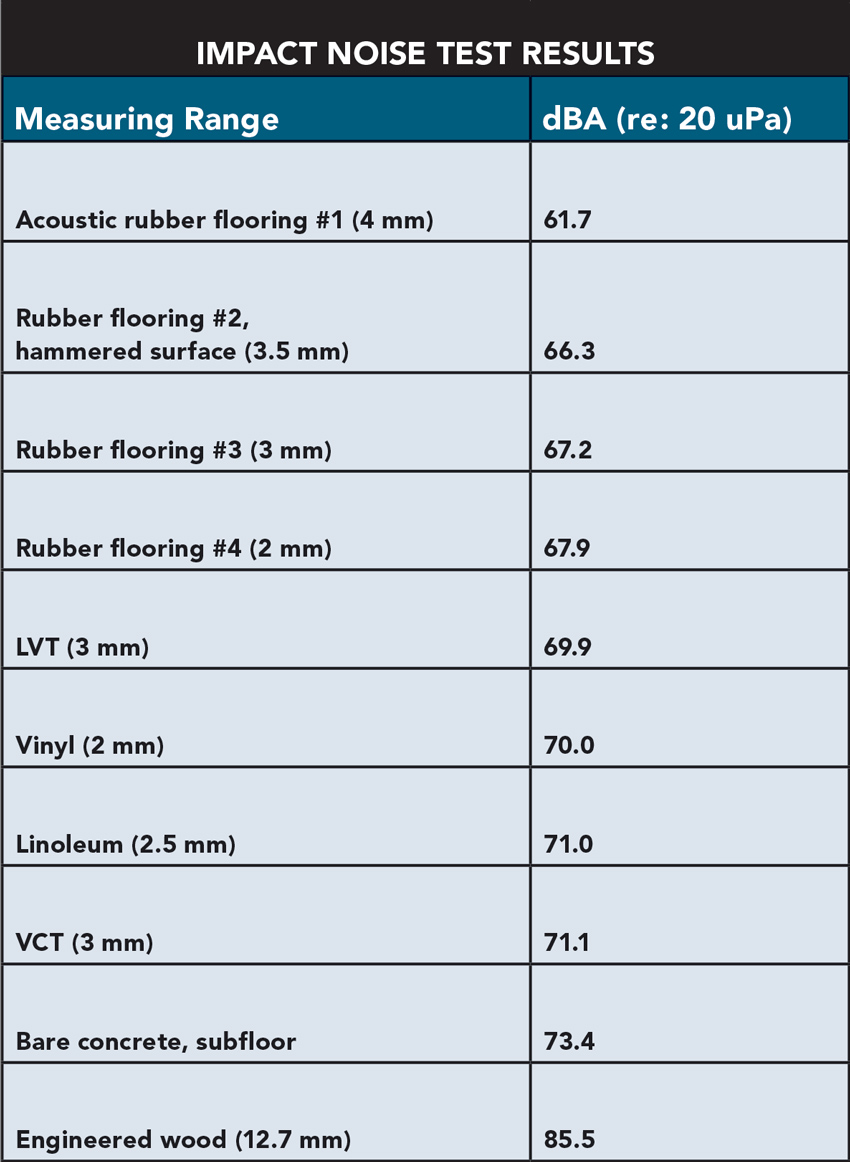
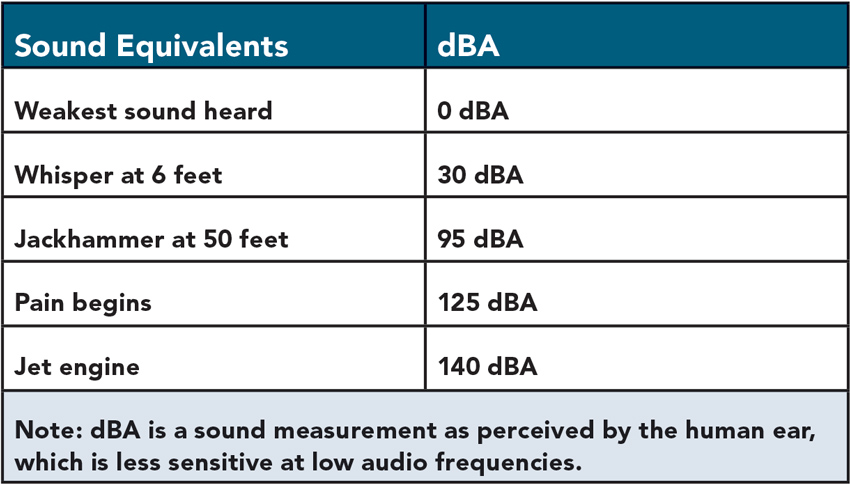
Background noise levels in unoccupied classrooms should not exceed 35 dBA.
Comfort for Concentration
“Schools should be comfortable visually, acoustically, and thermally, have excellent indoor air quality, be safe and secure, and good environmental citizens.” —The Third Teacher
Discomfort is a distraction. There is already stress enough in today’s intense learning environments; it is completely unnecessary to add the stress of hard floors, noisy interiors, and uncomfortable glare. In addition to providing a quieter atmosphere for learning, as discussed above, flooring can contribute to comfort and greater concentration in two other major ways: ergonomic and visual.
Comfort Underfoot: Musculoskeletal disorders account for one-third of all occupational injuries and illnesses reported by employers, constituting the largest job-related injury and illness problem in the United States. Indirect costs, such as lost productivity, retraining, and sick or administrative time, can be at least four to 10 times more than the direct costs. Teachers in particular spend most of their work day on their feet. Discomfort from fatigue, headaches, back pain, foot pain (not to mention from students) is common, but teachers, like most people, tend to take it for granted that the floor is going to be hard and standing for long periods is going to be uncomfortable, so they underestimate the difference that properly designed resilient flooring can make—until they stand and work on it for the first time.
As noted by Bob Cervi, director of facilities, maintenance, and operations for the Eanes School District in Austin, Texas (see Case Study), the premium rubber flooring installed in their schools has had a positive effect on reducing fatigue for teachers.
The comfort of rubber flooring was also a factor in its selection by Kentucky’s Scott County School District, says Mike Luscher, director of facilities. “We visited another school here in Kentucky that used the product in its cafeteria and lobby. I liked the feel under my feet. The floor had noticeable cushion.” The product was recently selected for the new 70,000-square-foot Lemons Mill Elementary School in Georgetown, Kentucky (see below).

The premium rubber flooring product selected for the new Lemons Mill Elementary School in Georgetown, Kentucky, was already in use in a number of schools in the district, so its durability and ease of maintenance were known quantities, according to Mike Luscher, director of facilities for Scott County Schools.
Unlike most hard floor coverings, rubber is a flexible material that absorbs the pressure of footsteps differently. Although “underfoot comfort” is often discussed, it has seldom been objectively measured. Numerous studies going back decades have focused almost entirely on the measurement of subjective fatigue due to prolonged standing on different types of floors and mats. As research technology rapidly evolves, more targeted testing is being developed, such as the use of near-infrared spectroscopy (NIRS) to measure oxygenation levels in the muscle as indicators of the stress of standing or walking on various surfaces.
A test recently developed by the University of Pittsburgh Bioengineering Department and a leading premium rubber manufacturer is designed to measure the direct impact of the forces experienced by the human body through the foot. As part of an extensive graduate study on human fatigue attributed to prolonged standing or walking on different flooring surfaces, this test method measures the reduction of ground reaction force (GRF) of floor-covering materials. When the foot strikes the ground during walking or running, the ground produces an opposite and equal force directed back to the foot. Using state-of-the-art pressure mapping equipment molded into a test shoe that is free of cushioning, this test allows the measurement of the return force imparted on the foot, through the floor covering, without the variable of footwear.
The test compared four premium rubber floor coverings and three other common resilient floor coverings (2.5-millimeter linoleum, 2-millimeter sheet vinyl, and 2-millimeter wood-look sheet vinyl) under identical conditions. Each floor covering was tested for 50 cycles, and the average GRF measured at the foot was calculated for each. Average GRF is calculated over one entire cycle of walking, from the time the heel first hits the floor through to when the foot is lifted from the floor. Flooring surfaces with lower measured GRF are reducing the impact on the body through the foot with each step.
Test results are shown in the graph below.
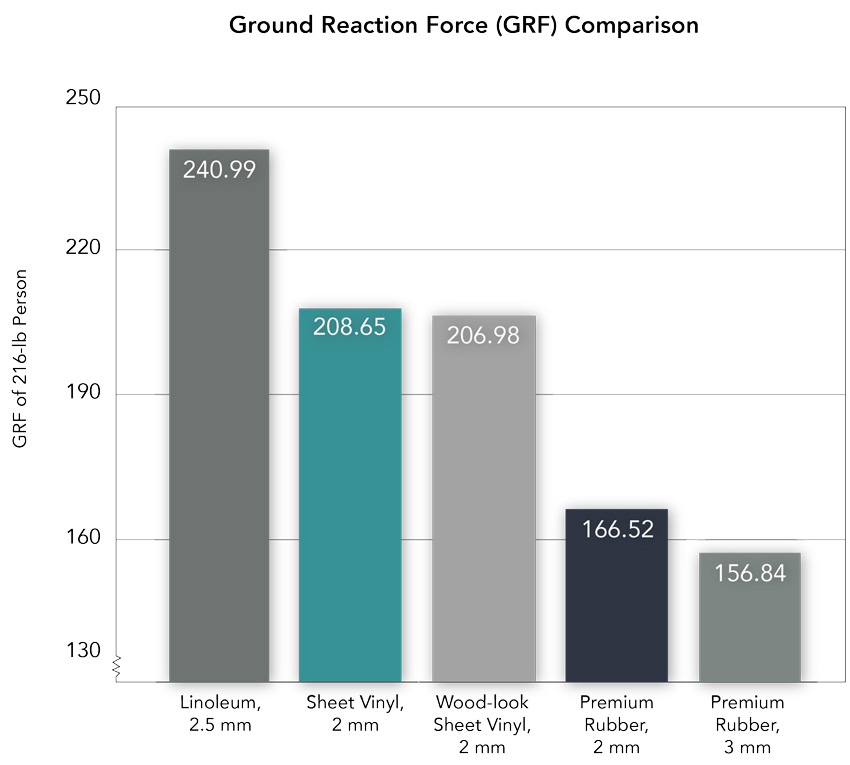
Note that the relative reduction in ground reaction force will vary depending upon the mass of the person and the walking gait. The force of a 216-pound person’s foot impacting the floor will be greater than the 216-pound weight of the person due to the acceleration of the foot during walking.
Light and Learning: Natural daylighting is a keystone of the most effective and innovative learning environments. Since the landmark 1999 study by the Heschong Mahone Group showing that students with the most classroom daylight progressed 20 percent faster in one year on reading tests and 26 percent faster on math tests than students in environments with the least natural daylight, multiple studies have borne out the relationship between properly designed daylit spaces and the performance and well-being of students and teachers (more information can be found at numerous sources, including the Healthy Schools Network and “Do School Facilities Affect Academic Outcomes?” by National Clearinghouse for Educational Facilities). Humans seem to be naturally calibrated to function better in natural light, not just the bright sunlight, but even gray skies, and the changing light of clouds, seasons, and times of day.
The roles of windows, walls, and ceilings in daylighting design have been studied extensively, but the impact of flooring has received less emphasis. However, careful selection of flooring in educational settings includes a number of considerations. Light reflectance from floors can enhance daylit spaces, reflecting both natural and artificial light throughout the space, and translating into less need for lighting fixtures and energy costs. But very light colors of inferior materials can also present significant maintenance problems. More importantly, it is imperative for visual comfort and physical safety to avoid glare.
The people in the space might not even realize that glare is the source, but it can cause a number of problems. Glare decreases the ability to see, since the eye usually adapts to the brightest level of light, making it harder to see all of the areas that are dimmer, even if they are actually adequately lit. Thus, glare can cause annoyance and discomfort at the least but also eyestrain and headaches. On flooring, glare poses a slip/trip/fall hazard. The objective in the learning environment is to increase available light, while preventing glare, and rubber flooring presents options for achieving this. These considerations have also made their way into the LEED rating system, and the light reflective value (LRV) of surfaces is now referenced in LEED v4 for educational facilities.
Glare is primarily a function of the gloss of the flooring finish. Glossy finishes are inherent in many common flooring materials that require coating and regular waxing. Even many rubber flooring products have coatings that produce varying levels of gloss. Premium rubber flooring products without coatings, and with no requirement for waxing during cleaning and maintenance, are available in lighter colors, matte finishes, and textures that are compatible with effective lighting designs in classrooms.
A wide range of colors and design options is also important because of the psychological impact of color and visuals on human behavior, elements that can strongly impact a student’s attitude and ability to focus. The careful use of color is a technical necessity in new learning environments that are packed with electronic screens and visual media of every type. In the past, rubber flooring was appreciated for its performance but not associated with high style. Manufacturers have greatly expanded their product lines to provide extensive options in colors, patterns, and textures, as well as new technology for imprinting custom designs.
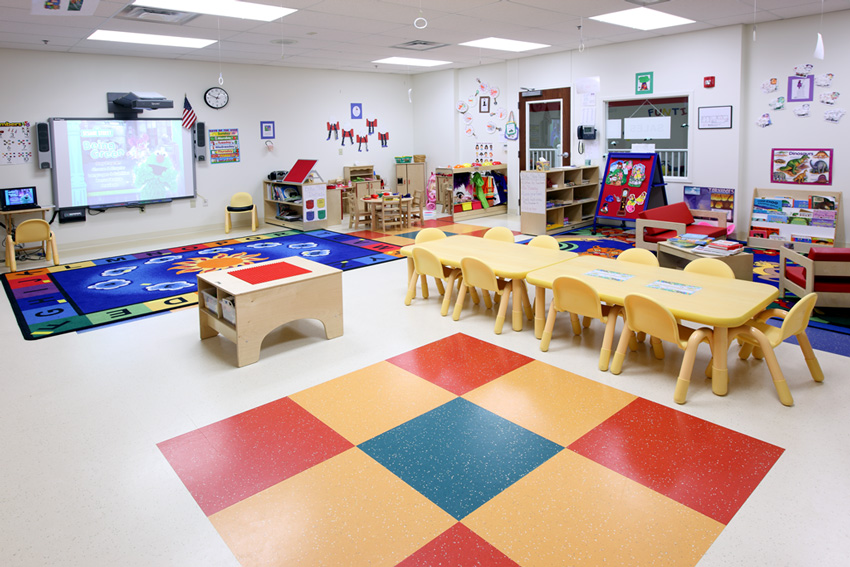
Creative use of premium rubber flooring is made at the new 26,700-square-foot Chickasaw Nation Child Development Center in Ada, Oklahoma, where classrooms, restrooms, play areas, offices, and infirmary are modeled after buildings familiar to children, like the fire station, post office, flower shop, and candy store, in an effort to develop an overarching sense of community. Hallways bear street names, and walls are decorated with murals that depict popular nursery rhymes
DURABLE FLOORS FOR DEMANDING SPACES
As discussed above, flooring in advanced learning environments has to stand up to more stress, accommodating multimedia, multiple purposes, moving furniture, and moving students. It should be resistant to scratches and other damage, and have a surface that does not require constant removal of scuffs and stains in order to provide a clean, appealing appearance.
Most of today’s school buildings, from neighborhood K-12 schools to community colleges to large university facilities, operate almost year-round. Regular classes might go into June and start back in August, with summer school in between. Schools are also increasingly used for community activities, extension classes, research and faculty training, even disaster response centers. People are in the buildings for many hours a day, most days of the year. Floors that require spaces to be closed for long periods of time for stripping, chemical cleaning, and waxing are becoming unaffordable, both in terms of cost and disruption. One of the key advantages of uncoated premium rubber flooring products is that they can be cleaned with little more than tap water. Buildings can remain open and functioning, with much less down time. But even more important, toxic chemicals and the associated fumes, disposal issues, and negative environmental impact are avoided on a daily basis.
The surface density of the flooring product in large part determines its maintenance profile, stain resistance, and durability, and there are significant differences among resilient flooring types. Many resilient floors require finishing due to their porous surface. If left unsealed, the factory-applied coating becomes scratched and dull, and the coating wears off due to daily foot and equipment traffic. Even some lower-quality rubber flooring products require finishes.
However, premium rubber products have extremely dense surfaces (see Figure 1). Their surfaces and structural integrity are maintained without the need for additional coatings.
Premium rubber flooring products are highly durable and should be selected after reviewing examples of facilities where the product has been installed in high-traffic educational settings and performed well over decades (for example, see the Grand Valley School Case Study). Durable rubber flooring materials not only avoid the damage caused by cleaning chemicals, but they resist staining from more mundane spills and liquids and the wear of high-traffic footfall, rolling equipment, and changing room configurations.
A long product life cycle of 30 years or more is an important component of a product’s overall sustainability and environmental impact. Wear-resistant rubber flooring provides a cost-efficient industrial flooring solution. Rubber flooring is reparable, also, so damage to a small part of the floor that would require complete replacement with other materials can be easily welded if gouged or scratched.
Although cost savings in operation and durability are always top of mind with administrators and school boards, as with all the issues discussed above, the most important costs to be considered are those borne by teachers and students when less-costly materials detract from a healthy learning environment.
WHAT’S AT STAKE
“The indoor environment has a direct, significant impact on a student’s health, safety, and ability to learn, as well as an educator’s ability to effectively teach andcommunicate with students.” —The Third Teacher
Advances in educational thinking and in design make new demands on flooring, as with other materials. High-quality flooring is an essential component of today’s best possible learning environments. The quality of the flooring will have an impact on the space’s air quality and sustainability, and will stand up to the stress of multiple uses, quick turnover, changing furniture configurations, and constant movement. The right flooring supports the effective use of light, the creation of a quiet space that enhances communication and reduces the distraction of discomfort from glare and fatigue. Perhaps most important, flooring should be selected on the basis of safety from accidents and falls.
The physical environment of the classroom is working constantly, all day every day, either for or against the adults and children who spend their hours there. A big part of the difference is right under their feet.
END NOTES
1OWP/P Architects, VS Furniture, and Bruce Mau Design. The Third Teacher: 79 Ways You Can Use Design to Transform Teaching & Learning. New York: Abrams, 2010. Print.
Layne Evans is a writer specializing in architecture, construction, the building industry, energy, and the environment. She has created more than 50 print and multimedia continuing education courses.

|
nora systems, Inc. Ideal for healing environments, nora® helps you develop functional, sustainable rubber flooring solutions that reduce maintenance time and costs, improve indoor acoustics, enhance indoor air quality, and provide the people in your facility with added comfort underfoot. http://www.nora.com/us/ |


